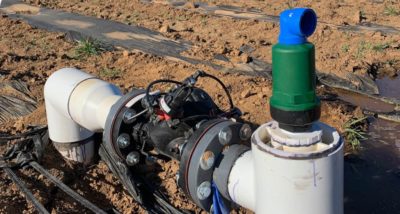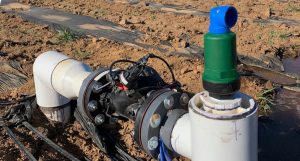How hemp, cannabis growers use technology, automation to cut costs amid pandemic
FeaturedIndustrial Hemp NewsMarijuana Laws, Regulations, & Politics June 29, 2020 MJ Shareholders 0



(A version of this story originally appeared on Marijuana Business Daily.)
Hemp and cannabis cultivators are turning to technology and automation to help achieve efficiencies, cut costs and keep workers safe during the coronavirus pandemic and the current economic downturn.
Growers report technology and automation solutions include:
- Automated irrigation, fertigation and HVAC systems to limit the amount of labor needed in the operation.
- Robots to place early-stage plants in growing media and on cultivation trays.
- Machines to fill and roll pre-rolled joints.
- Mold and microbial remediation systems.
Derek Du Chesne, president of Exactus Hemp, a hemp cultivation operation with 200 acres in Cave Junction, Oregon, is using robots for germination. The machines drop seedlings into squares of rockwool on trays, where they sprout in greenhouses before field planting.
Exactus uses drones for surveillance to monitor how its crops are protected and to ensure its irrigation system is working properly.
The company also uses machine trimmers after the biomass is hand-shucked.
Companies that were on the fence about buying new technology or adding automated equipment have been spurred on by the crisis.
“COVID is accelerating companies’ plans and technology implementation,” said Jon Vaught, CEO and co-founder of Lafayette, Colorado-based Front Range Biosciences, a cannabis biotech firm.
Ahead of the curve
Chris Wren, vice president of operations for Las Vegas-based Planet 13, a vertically integrated cannabis company, said his firm began with a high-tech operation in mind.
“We started off the grow at a really high level of automation,” he said. “That’s helped us leaps and bounds.”
For example, the company uses a sophisticated technology system to monitor, record and adjust the climate controls within its indoor grow room.
Most of the daily garden tasks like watering and fertilizing are taken care of by the automated system, though the company still uses human trimmers to maintain a level of quality.
Wren said the company experimented with machine trimmers, but the flower still required a touch up by hand.
A temperature probe to check all employees is the primary new technology Planet 13 has implemented since the COVID-19 outbreak.
But Wren points out that his company ran a very clean and hospital-grade system from the start. The entire facility is designed to protect against disease.
Looking ahead, if the company continues to scale up, he’s considering purchasing a robotic transplanting and potting machine that would place clones or starts in individual rockwool blocks.
Safety first
Vaught at Front Range Biosciences emphasized that many cannabis companies are focused on workplace safety.
“It’s about using tried and true methods to protect your workers and keep operations going without having 30% of your team going out sick or on quarantine,” he said.
He recommends developing improved workflows and standard operating procedures to maximize production efficiency.
Implementing new automation systems in a cultivation facility can take several months, even up to a year, but it’s necessary in a competitive environment such as Colorado where prices have fluctuated and consolidation is occurring.
“Labor is often one of the most expensive pieces and challenging in terms of scalability,” Vaught said.
Like Wren, Vaught sees a future for robots that place cuttings in rockwool blocks as a way to improve efficiency.
Important for scaling up
Automation and technology are key to expansion for Cresco Labs, a vertically integrated multistate cannabis company based in Chicago.
Todd West, executive vice president of operations, said the company uses automation and technology to track lighting, irrigation and climate controls.
He uses crop-steering technology to monitor the health, growth and yield of his plants.
That attention to detail also helps when selecting genetics because the reports show the attributes each strain possesses.
He’s looking to add more automation to his workflow, particularly in the area of filling and labeling products.
While he acknowledges it takes up to five months to receive a new piece of equipment after it has been ordered, the return on investment can be quick.
“A piece of equipment that could give you 10 times more output could pay for itself in 6 to 9 months,” West said.
Joint rollers
Many advanced cannabis companies are using automation in other ways, especially for irrigation and fertigation.
“Gone are the days of dragging a hose and pumping water room by room,” said Joe Caltabiano, a Chicago-based cannabis entrepreneur and Cresco Labs co-founder.
Automated systems allow growers to control proper doses of nutrients, water amounts and much more.
The adjustments can all be made from a control room, which limits the amount of time a worker needs to spend in the facility. Plus, the systems use less water.
Caltabiano estimates automation can reduce operational costs by 20%, though the systems can require a sizable up-front investment.
Many cultivation operations are adding machines to roll and fill joints, or pre-rolls, where in the past it might require 25 or so workers to roll everything by hand, Caltabiano said.
But it should also be noted that with the coronavirus pandemic and the fact it’s a respiratory illness, some consumers may shy away from shareable, smokable products such as joints.
Inside the box
Denver-based growers Bonsai Cultivation point to a post-remediation piece of technology as a way the company has been able to keep workers from touching the plants as often.
According to Mark Radtke, CEO of Bonsai, The Box, which uses “reactive oxygen” to help eliminate mold and microbials, has sped up the company’s production process.
The company can send out cannabis to be tested much more quickly, and the flower is handled less, thereby reducing the amount of labor.
According to Radtke, prior to adding this piece of equipment, Bonsai was losing about 70-85 pounds of flower a month, and at $1,000 a pound wholesale that can add up.
“It also keeps the room cleaner, with less people walking back and forth in the room,” Radtke said.
Bonsai is also considering switching out its more traditional high-pressure sodium lights for LEDs, which require less electricity to operate. The company had been holding off because it wasn’t sure LEDs could produce a high-enough yield.
“We’re hearing now that it may be time for another look,” said Richard Batenburg, president and chairman of Cliintel Capital Management Group, which operates Bonsai.
Bart Schaneman can be reached at [email protected]
For more of Hemp Industry Daily’s ongoing coverage of the coronavirus pandemic and its effects on the cannabis industry, click here.
MJ Shareholders
MJShareholders.com is the largest dedicated financial network and leading corporate communications firm serving the legal cannabis industry. Our network aims to connect public marijuana companies with these focused cannabis audiences across the US and Canada that are critical for growth: Short and long term cannabis investors Active funding sources Mainstream media Business leaders Cannabis consumers










No comments so far.
Be first to leave comment below.